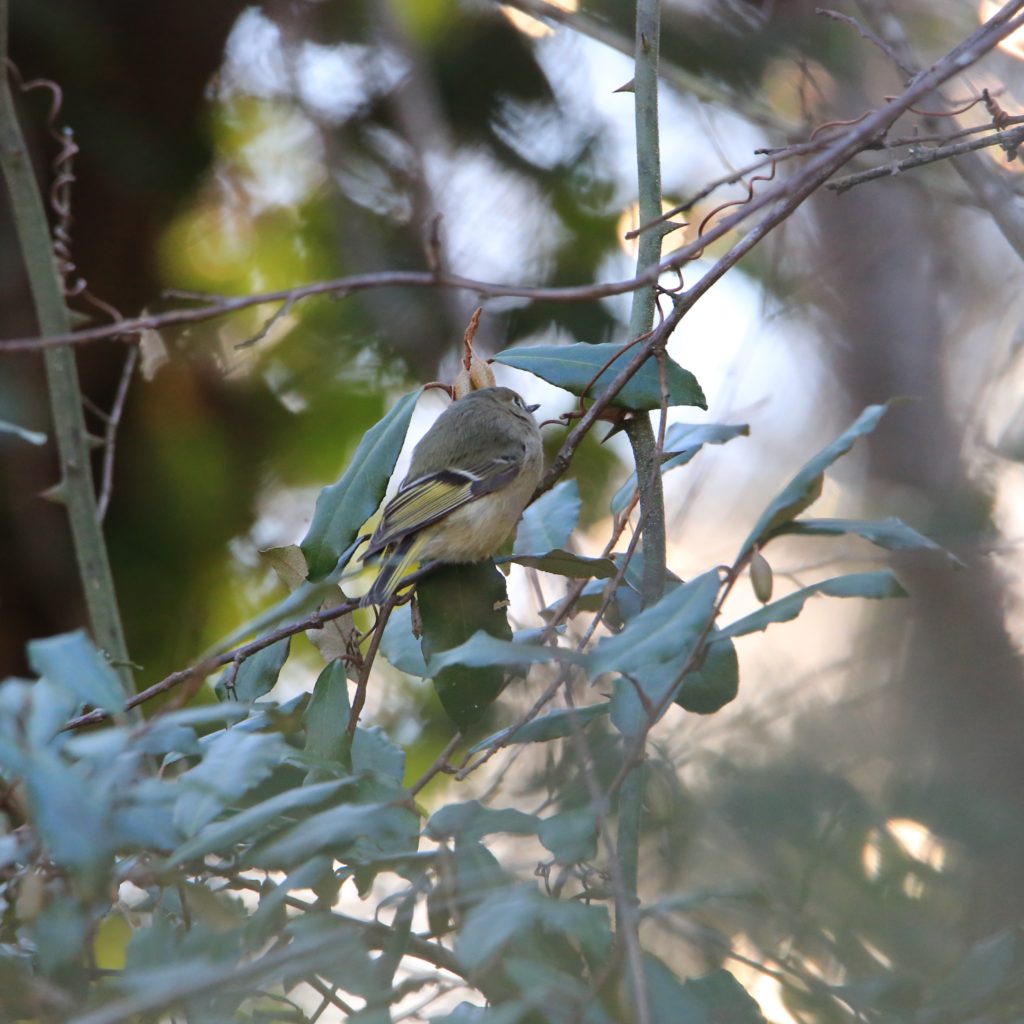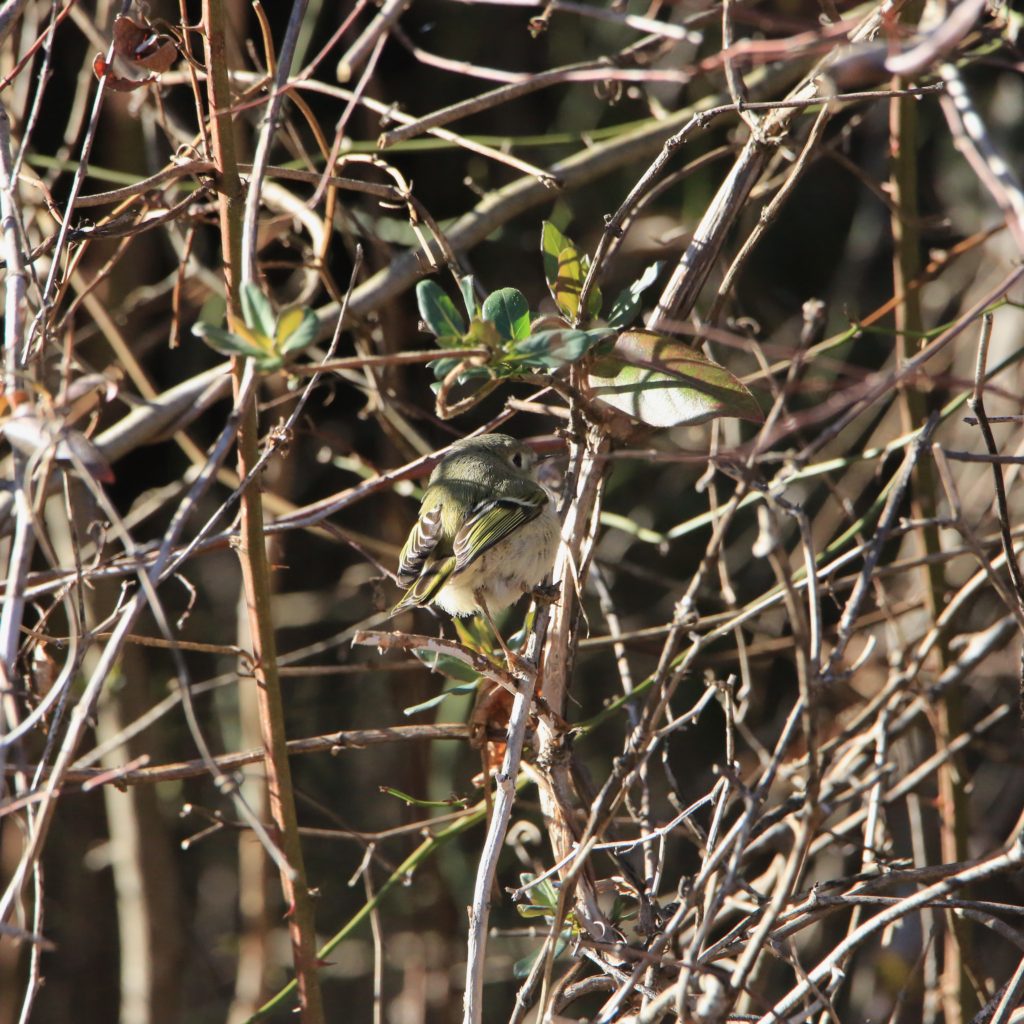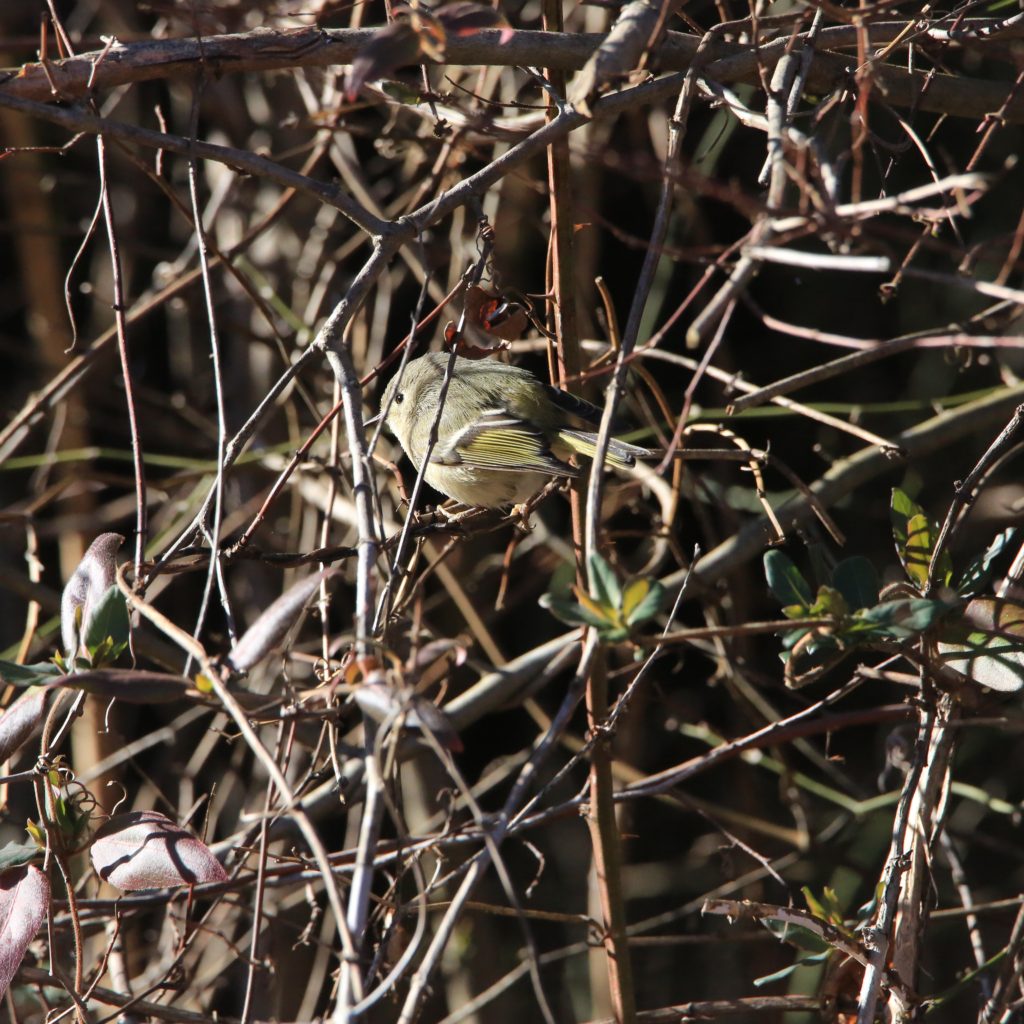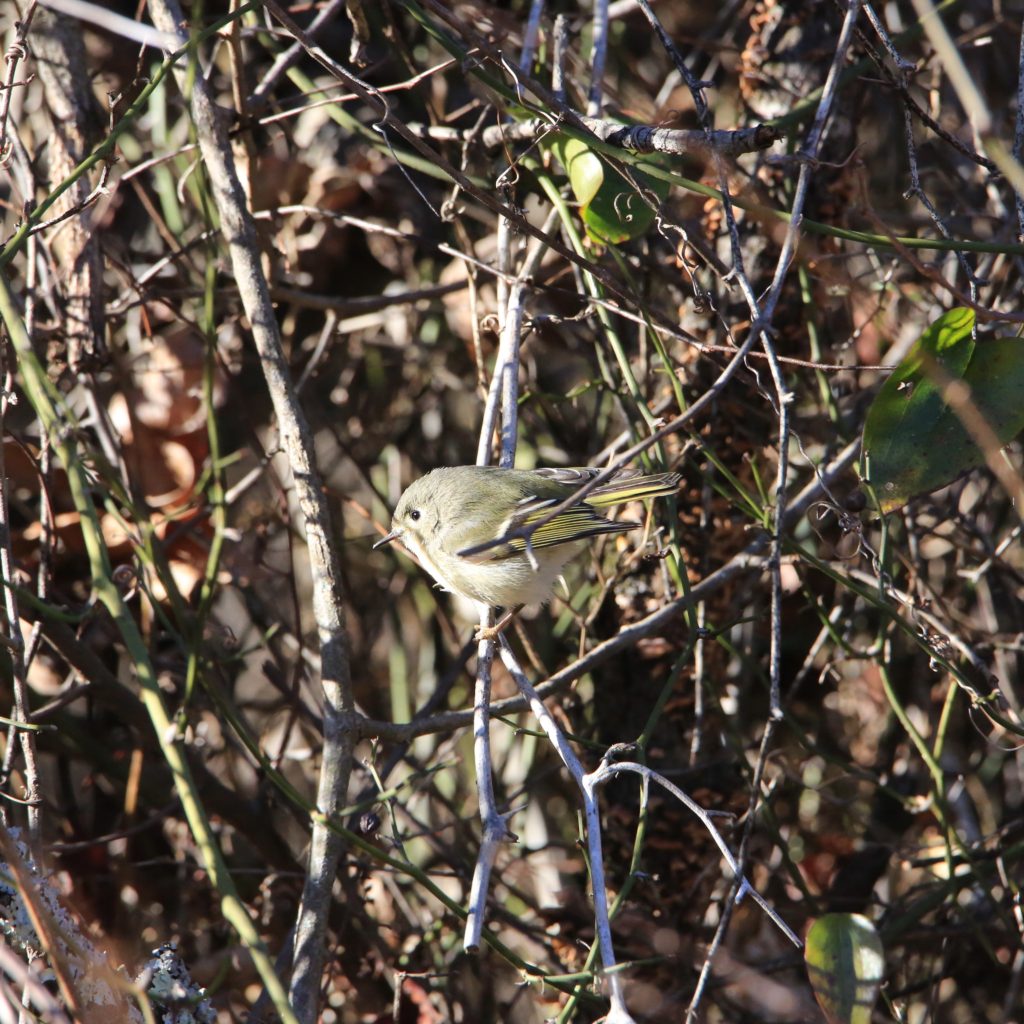
The Ruby-crowned Kinglet is a small species of Kinglets, also known as the Regulus calendula. First identified by Carl Linnaeus in 1766 in his landmark Systema Naturae. Named after the identifying feature of a deep red crown on adult males. Lacking the dark stripes of its Kinglet cousins, and the vastly different vocalizations have led to the idea that it belongs to a completely different genus. Its scientific name, Regulus calendula just like the bird hides a very interesting clue about it. Its genus, Regulus means “Little King”, just like its namesake, when agitated it begins to flare its Ruby Crown.
About Ruby-crowned Kinglets
A small Kinglet, which is amongst the smallest songbirds in North America that are known for its beautiful plumage, adaptability, and bravery.
● Ruby-crowned Kinglets Photos, Color Pattern, Song
● Ruby-crowned Kinglets Size, Eating behavior, Habitat
● Ruby-crowned Kinglets Range and Migration, Nesting
GET KIDS BIRD WATCHING
Ruby-crowned Kinglet Color Pattern
Ruby-crowned Kinglets are identified by their olive-green plumage. Male Kinglets have the namesake ruby/scarlet-colored patch on their crown. On some rare occasions, they can be found with orange, yellow, or a lack of colored patches. They have a white ring around their eyes and two white stripes along with their wings.
The underside of their body is also white, along the sides and back they are of olive-green color with each feather having a white stripe along the length of it. Their wingtips are white with green edging over the grey wing coverts. They have black-brown bills and brown legs and feet, the underside of their feet is a pale yellow. They also have brown irises.
Female Ruby-crowned Kinglets lack the scarlet patch upon the head but look very similar to their male counterparts. Juvenile females look like a paler version of adults. Juvenile male Ruby-crowned Kinglets lack the scarlet patch initially and gain them during their first summer.
Description and Identification
Finding Ruby-crowned Kinglets can be a difficult task. They are found in dense forests and thickets and can be seen momentarily through the foliage before they zip past. They are very fast, energetic birds, keeping sight of them can be a very rare occurrence. They spend a lot of time hopping around the forest understory in search of their prey. They can be seen in nests at around 12 meters on trees along the trunk.
Identifying can be slightly confusing, as their “Ruby Crown” is not visible unless the adult male is agitated or displaying thus relying on other methods is required. One such method is the way the Kinglet flicks its wings at a constant pace, one must be careful though as the Hutton’s Vireo is often misidentified as a Ruby-crowned Kinglet due to their similar plumage and similar method of flicking wings, but the speed of the Kinglet is much faster than the Vireo
The best method to identify the Ruby-crowned Kinglet is if one is able to find displaying and singing males, who will flare their ruby crowns as a part of their attempt to assert dominance.
Ruby-crowned Kinglet Song
The Ruby-crowned Kinglet Song is a series of chattering and warbling notes. Often can be heard in their breeding grounds during the season, primarily sung by adult males to display to dominate other male Ruby-crowned Kinglets. Oddly, it can also be heard in their preferred grounds for wintering and during their migration during spring. Male birds sing during their puffed chest display, whether or not other Adult males are present to be threatened. Another clearly audible call is their alarm call that makes other birds aware of an unwanted arrival on their grounds.
Western Ruby-crowned Kinglets often have more variation than their eastern counterparts.
Ruby-crowned Kinglet Size
Ruby-crowned Kinglets range in size between 3.5-4.5in from tip to tip, they are quite average-sized Kinglets, much like their family they weigh anywhere in between 0.3-0.4oz. The little birds have a wingspan of 6.3-7.1in. Their small size often making them hard to find, the adult male flares its namesake “ruby crown” to seem larger than its actual size, although barely. About the same size as their cousins the Golden-crowned Kinglet they’re much smaller than many
of the songbirds, such as the Warbler.
Ruby-crowned Kinglet Behavior
Ruby-crowned Kinglets are energetic birds that spend a lot of their time on the forest understudy flying slightly above the ground searching for insects to eat in the foliage. Other than that, they spend their days flying, nesting, roosting, and sleeping.
Adult males begin to migrate to their breeding grounds before the females, often asserting their dominance over fellow male rivals. Upon facing a male rival, they begin to exhibit aggressive displays. While displaying adult males lean forward and their ruby crowns begin to erect. They raise their rumps and display their wings to assert dominance while singing and moving their heads side to side. They often chase and attack other species of birds, not only their male rivals to ward them off. Often attacking other species such as the Golden-crowned Kinglet with more aggression than the male rivals of its own species.
The adult females come later, initiating the breeding season. The courtship of the Ruby-crowned Kinglet begins in early May when the adult male identifies his preference for a mate. Upon approaching, the adult male hops around from branch to branch with a raised rump and flared “Ruby Crown”. As it gets closer it begins to sing its song, and if accept the female begins to flutter her wings. The male then approaches her and then they both enter a shrubbery where they mate. In an inverse, females leave for the fall migration before the male Kinglets.
Ruby-crowned Kinglet Diet
Ruby-crowned Kinglets’ eating habits are spread through a vast diet. Like many birds, Ruby-crowned Kinglets enjoy insects, particularly revere the flying kind, primarily feasting on moths, wasps, spiders, and ants. The lack of insect prey does not bother them far too much as they are able to sustain. Hard seeds, fruit, berries, and most vegetable matter. Sometimes even found sustaining on tree sap. Upon the arrival of winter, they depend mostly on insects and their eggs. During their mating seasons, they do not consume any vegetable matter.
Ruby-crowned Kinglet Habitat
The Ruby-crowned Kinglets are not picky in terms of habitat often living across a vast array of habitats varying from region to region. In the east they are often found in dense forests and in the west are commonly found in mixed or coniferous forests. Found in woodlands, dense thickets, scrubs, or even open habitats. During their winter migration, they’re found amongst tropical, semi-tropical, humid, or semi-deciduous forests along with central America and Mexico enjoying the warm weather. Their spring migration leads them to the coniferous, deciduous, and floodplain forests in search of the dense forest understory. Often during the spring, they are also known to inhabit backyards.
Range and Migration
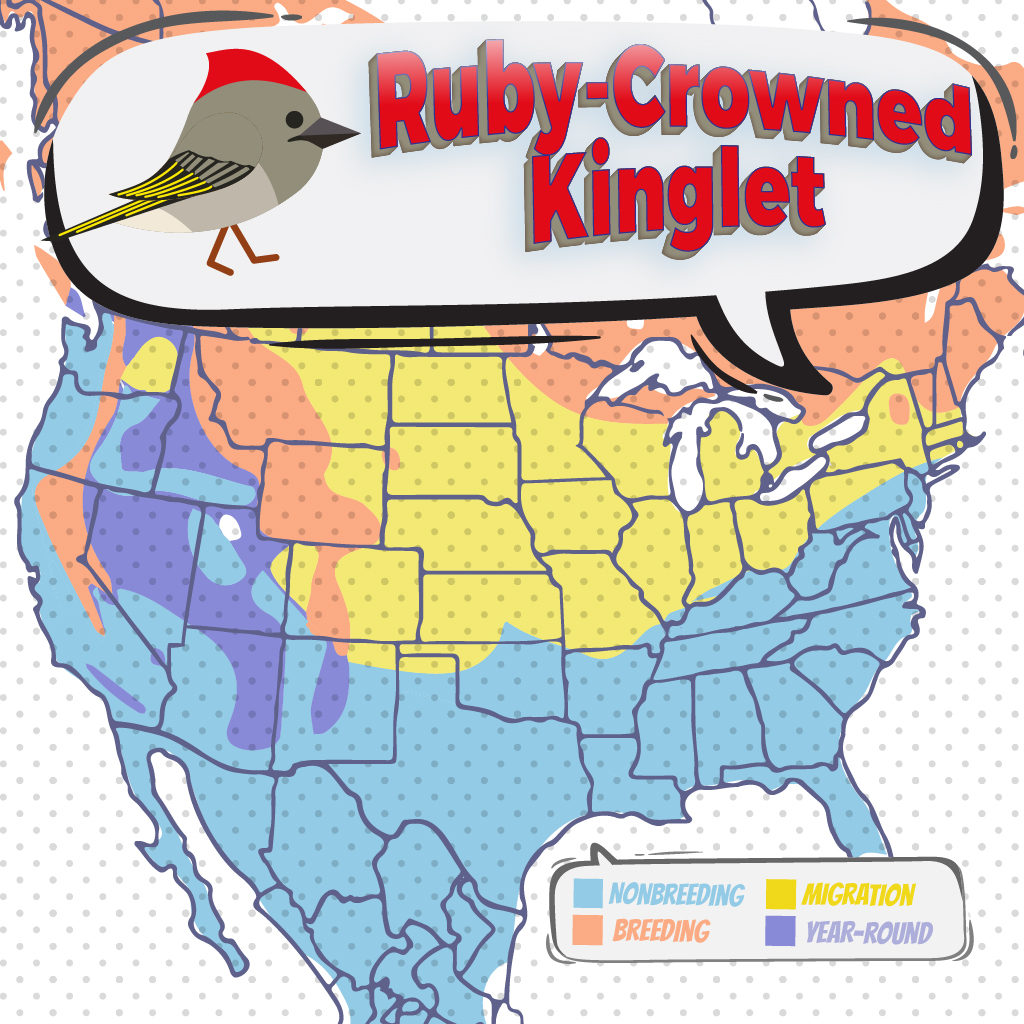
Ruby-crowned Kinglets are an odd bunch, considered short-distance migratory birds most of their population enjoys their breeding grounds in North America around Canada and Alaska, upon the arrival of winter they leave for their wintering grounds, the tropical and humid forests of Central America in Mexico where it hopes to find space to nest and a forest understory to forage in for food. Except for the western population which seems to enjoy permanent residence in its breeding grounds in North America. Upon the arrival of spring, the rest of the population returns to their grounds in North America to start their breeding season.
Ruby-crowned Kinglet Lifecycle
The Ruby-crowned Kinglet only raises broods once a year, in May adult males begin to court the females, after which a nesting ground is chosen.
The female Ruby-crowned Kinglet even though a small bird lays between 5 to 12 eggs. The color of the egg can be white, off-white and in some cases even slightly brown. They are small, oval in shape and completely smooth. The female takes about 7-12 days to lay the entire clutch and begins to incubate for 12-14 days during which the female bird is fed by the male bird, who upon hatching immediately starts to assist the female in feeding the hatchlings. After 12-17 days, the hatchlings begin to fledge.
Both male and female birds sexually mature at the age of one year. The average lifespan of the bird has not been recorded, but the oldest ever Ruby-crowned Kinglet was aged 5 years and 7 months.
Nesting
After choosing a mate, around May the female Ruby-crowned Kinglet chooses a suitable nesting site and begins to build its nest out of mosses, lichens, feathers, cocoon silk, spider webs, and pieces of bark. They also use twigs, roots, grasses, and conifer needles, while the lining is composed of feathers, fine grasses, plants, lichens, and animal fur.
The female chooses the location based on the protection the canopy in the forest is able to give it, mostly found on tall trees at about 12m above ground level some higher nests can be found up to 27m about the forest floor. Nests are about 12cm in depth and 10 cm in diameter, large in size to accommodate the large number of eggs that Ruby-crowned Kinglets lay. Another feature of the nest is that it is almost elastic, stretching to accommodate the large number of eggs.
Many songbird nests are often the site for the parasitic eggs of the cowbird, which reduces the chances of survival for the clutch of the bird that raises the cowbird as one of its own. The sheer difference in size in the birds causes the Ruby-crowned Kinglets to reject the cowbird hatchlings which makes the best immune to the nest-parasite cowbird.
The large clutch laid and the immunity from the effect of the cowbird should cause large numbers of these little songbirds, but they only serve to offset the large 80% adult mortality rate found.
Anatomy of a Ruby-crowned Kinglet
Ruby-crowned Kinglets are small stubby birds. Their heads are quite large for their size with slight domes at the back above the nape. They have flat foreheads. Their large heads lead to a lack of visible neck. Their bills are long and thin with no curvature. Ruby-crowned Kinglets’ feet are anisodactyl, meaning they have 3 primary talons ahead with a hallux talon behind, making them suitable for perching on branches. They have between 1,119 to 4,607 feathers. Their identifying feature, the rub patch on the crown is usually hidden unless the adult males are agitated or aggressive upon which they flare the patch to seem threatening.
Final Thoughts
The vast habitat that the Ruby-crowned Kinglet can inhabit anytime except the breeding season has allowed it to adapt and thrive. This has kept a bird with a huge adult mortality rate at a “species of least concern” in terms of conservation, but recent trends show a decline in numbers due to a loss of habitat due to logging activities and wildfires, along with being a species that is predated by house cats.
Another threat to them is their collisions with towers and windows and the cold die-offs that take place, especially in particularly cold years.
The Ruby-crowned Kinglet is a bird-filled with personality, often willing to spend it is time displaying and foraging, all while zipping from branch to treetop. Not much larger than a Hummingbird it still manages to scare off bigger birds from its breeding grounds. The adult male is known to pretend like it has a broken wing in order to lure predators away from its nest in its fearless defense. Often known to attempt to fight anything, from house cat, squirrel, or even a human being.
The smallest songbird in North America willing to fight beings hundreds of times its size, it seems to earn its name as the “Little King”.
Ornithology
Bird Watching Academy & Camp Subscription Boxes
At the Bird Watching Academy & Camp we help kids, youth, and adults get excited and involved in bird watching. We have several monthly subscription boxes that you can subscribe to. Our monthly subscription boxes help kids, youth, and adults learn about birds, bird watching, and bird conservation.
- Kids Bird Watching Monthly Subscription$10.00 / month
- Kid & Adult Bird Watching Starter Pack Subscription$10.00 / month and a $72.00 sign-up fee
- Kids Bird Watching Starter Pack Subscription$10.00 / month and a $19.00 sign-up fee
Bird Watching Binoculars for Identifying Ruby-crowned Kinglets
The most common types of bird watching binoculars for viewing Ruby-crowned Kinglets are 8×21 binoculars and 10×42 binoculars. Bird Watching Academy & Camp sells really nice 8×21 binoculars and 10×42 binoculars. You can view and purchase them here.
- Birding Binoculars$49.99
- Kids Binoculars$13.99
Ruby-crowned Kinglet Stickers
Stickers are a great way for you to display your love for bird watching and the Ruby-crowned Kinglet. We sell a monthly subscription sticker pack. The sticker packs have 12 bird stickers. These sticker packs will help your kids learn new birds every month.
Bird Feeders For Ruby-crowned Kinglets
There are many types of bird feeders. Here are our favorite bird feeders for your backyard. We use all of these bird feeders currently. Kids will have a great time watching birds eat at these bird feeders. Using this collection of bird feeders will provide a wide variety and many types of birds.
Best Bird Houses For Ruby-crowned Kinglets
There are many types of bird houses. Building a bird house is always fun but can be frustrating. Getting a bird house for kids to watch birds grow is always fun. If you spend a little extra money on bird houses, it will be well worth every penny and they’ll look great.




